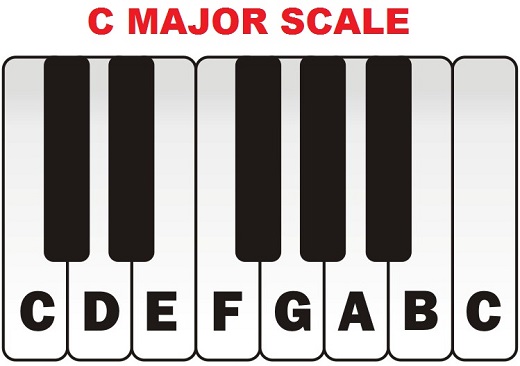A scale is a repetitive rising or falling series of notes within the range of an octave. Choosing the right notes from a scale is useful for creating melody and harmony.
In a melody we use the notes successively.
In a chord we use the notes are played at the same time.
Type of scales
There are many scale types out there : chromatic , major , minor, pentatonic, microtonal, modal, octatonic, hexatonic and exotic scales.
The Major Scale
there is something universal about the major scale that appeals to everyone
We can say that the major scale is bright sounding scale, and can express strong emotions. To understand the major scale, we need to understand firs the music-key. The Key is the note upon with the scale is built.
The most easy scale to learn is the C major scale. This is because is compose by all white key in an octave. So as long as you know where C is located ( on the left of the group of two black keys ).
In a melody we use the notes successively.
In a chord we use the notes are played at the same time.
Type of scales
There are many scale types out there : chromatic , major , minor, pentatonic, microtonal, modal, octatonic, hexatonic and exotic scales.
The Major Scale
there is something universal about the major scale that appeals to everyone
We can say that the major scale is bright sounding scale, and can express strong emotions. To understand the major scale, we need to understand firs the music-key. The Key is the note upon with the scale is built.
The most easy scale to learn is the C major scale. This is because is compose by all white key in an octave. So as long as you know where C is located ( on the left of the group of two black keys ).
Intervals
C major scale is called major because it has a particular pattern of intervals. An interval is the gap between two notes also called semitone. In C major scale we can notice that not all the intervals are the same size.
In an octave we have 12 semitones ( as u notice we have 7 white keys and 5 black keys they each represent a semitone) that have pitches and this gives form to what we call chromatic scale.
In the C major scale we use just 7 semitones , and this are the white key as we mentioned before.
If we look closer to the c major scale we notice that in-between C and D we have a black key, so that means from C to D there are two semitones, and we call this a tone. If we go forward between E and F there is no black key , and that step is called semitone. Fallowing this we can get to this formula :
C major : T - T - S - T - T - T - S *where T is tone and S is semitone.
You can apply this pattern to form any major scale of any key.

Comments
Post a Comment